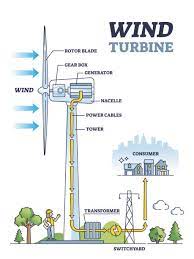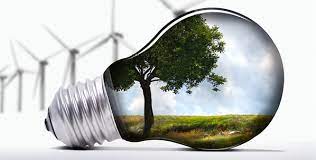wind energy
Wind energy works in a process in which the mechanical energy of the wind is converted into the form of electricity. This energy is referred to as a sustainable force just like solar and hydro. This type of electricity is among the cleanest and produces 100% electricity with zero waste emissions. Its production capacity is about 20% of the sector's capacity. Let's first examine how wind generators generate power. If that is the expression, then the language generated using the fluid consumes some amount of electricity generated in the manner of a moving fluid including the turbine in the mill is one of the simplest types of mills. The large rotating blades you notice are on the front of the windmill. The blades are designed in a curved shape similar to the wings of an airplane. When the wind blows at the back of the mill wings, it introduces upward pressure to lift. The functions of the wind blowing through the wings of the mill have a rotating effect on them. Roughly the amount of kinetic energy lost by the wind is the same as the amount of kinetic energy that the windmill picks up except for some energy losses due to friction. The amount of power that a windmill produces becomes approximately the same as the area covered by its fins. This means that the longer the wings, the higher the efficiency of the turbine in a windmill. Wind power is the main factor of wind energy. When wind speed is doubled, the two winds give 8 times the amount of energy they produce at normal speed.
The main parts of a windmill The amount of kinetic energy lost by the wind is the same as the amount of kinetic energy absorbed by a windmill. Some electrical losses are due to friction. It is proportional to the amount of power that a windmill reports in its share of the area covered by its wings. Complete it on every occasion it makes it easier for you to regain your strength. The wind is the main cause of wind force production. Wind turbines generate 8 times the amount of energy they carry at normal speed. The main parts of a windmill.
How do windmills work
We will look at the working principle of a horizontal axis mill. The wings of the turbine are rotated by the kinetic energy of the wind. These wings are supported by a central shaft that supports the blades. Compared to a turbine, the central axis rotates very slowly.
The most modern windmill can face the wind at the best angle so that you can use the wind energy in the best way.
The blades are controlled with the help of small electric motors or hydraulic pistons which are controlled to rotate by a precise electric mechanism. A smaller turbine has more mechanical control over its rotation.
We continue to present the main structure of the windmill called the nacelle. A bus has two main components, the gearbox and the alternator. The gearbox converts the engine speed from low speed to high speed in a way sufficient to operate the generator successfully. A typical transmission rate for a gearbox ranges from about 16 rpm in the main shaft to about 1,600 rpm in the alternator. The generator is placed directly after the gearbox. The generator in the mill can generate about 2 million watts of electricity at 700 volts at high wind speeds
The anemometer is already considered the next important part of a windmill. This device is an automatic speed-measuring device that is installed on the rear deck of the bus. An anemometer provides measurements of wind speed and direction. It is possible to use this method and move the entire bowl and blades with the help of a yaw motor. The yaw motor is installed between the bus shaft and the tower.
If the weather is windy and turbulent, brakes are applied to prevent damage to the windmill. Use these brakes for safety reasons, as these high speeds may damage the treadmill. The brakes are also used during safety tests and maintenance work on wind turbines
The current generated by the windmill is transferred to a lift-driven transformer which serves to boost the voltage. This current can be effectively transmitted to the network over a long distance. Electricity is transmitted from the grid to the station's
positive wind energy
Wind power now does not pollute the surrounding environment and no longer uses dangerous chemicals, and chemicals like carbon dioxide, wind power does not contribute to global warming worldwide and does not emit greenhouse gases. Electricity from the wind does not run out. - Wind towers may be useful for people who live in remote areas, but it is difficult to run the power from the power plant to switch places - Agriculture and irrigation can be sites where wind generators are located. - Because of the possibility of the emergence of mills in the agricultural and marine areas south of the fixed arrangement of the fins, the low depression.
negative ywind energ
Electricity produced through it - is unpredictable and unstable, and this makes wind electricity suitable in case of excessive productivity and constant amount demand. Wind farms can be considered a nuisance to a few citizens in those areas. Wind farms are dangerous to birds. Wind farms may also interfere with radar by creating a hole in the radar coverage, causing national security.





Comments
Post a Comment